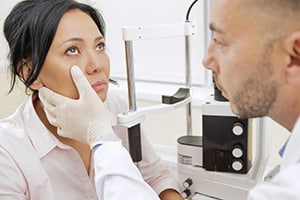Dry Eye
If your eyes are frequently red, itchy, and dry, you may be suffering from Dry Eye Syndrome. This condition is relatively common and can be caused by a variety of factors. At Prestera Eye, our eye doctors, Dr. Tory Prestera and Dr. Howard Guan, offer simple treatment options designed to alleviate the irritation caused by Dry Eye.
What Is Dry Eye?
Dry Eye is a condition that reportedly impacts more than 25 million people in the United States. In fact, it is one of the more prominent reasons why people visit the eye doctor in the first place. Dry Eye Syndrome occurs when the normal amount of tears that wet and lubricate the eye are simply not being produced. This lack of tear production often leads to increased sensitivity and irritation, sometimes producing debilitating symptoms that can affect one’s livelihood. Dry Eye can also make wearing contact lenses quite difficult, and even painful. While Dry Eye Syndrome often begins due to a lack of tears, it can later lead to excessive tearing as the lacrimal gland tries to overcompensate for the diminished lubrication. In some cases, individuals may believe seasonal allergies or other types of eye conditions may be what is causing the concern when the symptoms could actually be the result of Dry Eye Syndrome.
What Are the Symptoms of Dry Eye Syndrome?
Some of the most common signs and symptoms of dry eye include:
- An itchy or burning sensation
- Redness
- Watery eyes
- Light sensitivity
- Difficulty wearing contact lenses
- Blurry vision
- Eye fatigue
If you are experiencing some or all of these symptoms on a regular basis, you may be suffering from Dry Eye Syndrome. Please contact us today to schedule an appointment with one of our knowledgeable eye doctors. Following a thorough examination, they can help you find a treatment to help prevent further discomfort.
What Causes Dry Eye Syndrome?
 Dry Eye can occur as a result of one’s environment, such as dry or dusty locations, but it can also be the result of other concerns:
Dry Eye can occur as a result of one’s environment, such as dry or dusty locations, but it can also be the result of other concerns:
- Aqueous Deficiency – The lacrimal glands in your eyes are responsible for producing tears, which help lubricate the eye. Aqueous deficiency occurs when there is not a sufficient amount of tears being produced, meaning the eyes dry out easily and often.
- Meibomian Gland Dysfunction – The meibomian gland adds oils to the tears in your eyes, but if a blockage or other abnormality occurs, it can prevent the oils from being properly produced. This causes the tears to evaporate more quickly than normal, ultimately leading to dryness and discomfort.
- Blepharitis – Blepharitis is a condition of the eyelid that occurs when the oil glands along the lash line become blocked. While symptoms primarily affect the eyelids and surrounding skin, it can also sometimes cause Dry Eye.
How Is Dry Eye Treated?
As noted above, Dry Eye can be the result of various factors. Depending on your unique case, Dr. Prestera or Dr. Guan can recommend a treatment option that is most effective for addressing your specific underlying cause. Many patients find relief with medicated eye drops or artificial tears, but a punctal plug procedure can also help improve tear production, if necessary.
Medicated Eye Drops
Medicated eye drops are a common solution for treating dry eyes as they can help restore lubrication and reduce sensitivity. For many individuals, medicated eye drops can also effectively treat eyelid and corneal inflammation that can sometimes result from Dry Eye Syndrome. This treatment can be ideal for jumpstarting natural tear production and reducing symptoms associated with Dry Eye.
Punctal Plug Procedure
If medicated eye drops cannot sufficiently treat dry eyes and successfully diminish the resulting symptoms, a punctal plug procedure may be recommended. This treatment involves blocking the natural drainage of your eyes to prevent them from drying out. Punctal plugs are gentle devices that are smaller than the size of an average grain of rice. Our eye doctor will delicately insert them into the tear ducts to alleviate dryness. By preventing the natural draining of liquid in your eyes, the water is retained and can therefore reduce the corresponding side effects of Dry Eye Syndrome. Made of a biocompatible product, punctal plugs are available in two different iterations: temporary and semi-permanent. Temporary devices will eventually dissolve on their own after as little as one week or as much as six months. Semi-permanent devices (which are usually made of silicone) should last much longer. There are distinct advantages to each type of punctal plug; our doctor can help you determine which option is best for your needs.
Contact Prestera Eye Medical Group
To learn more about Dry Eye Syndrome and how it can be treated, or to schedule an appointment with one of our eye care specialists, please contact us today.